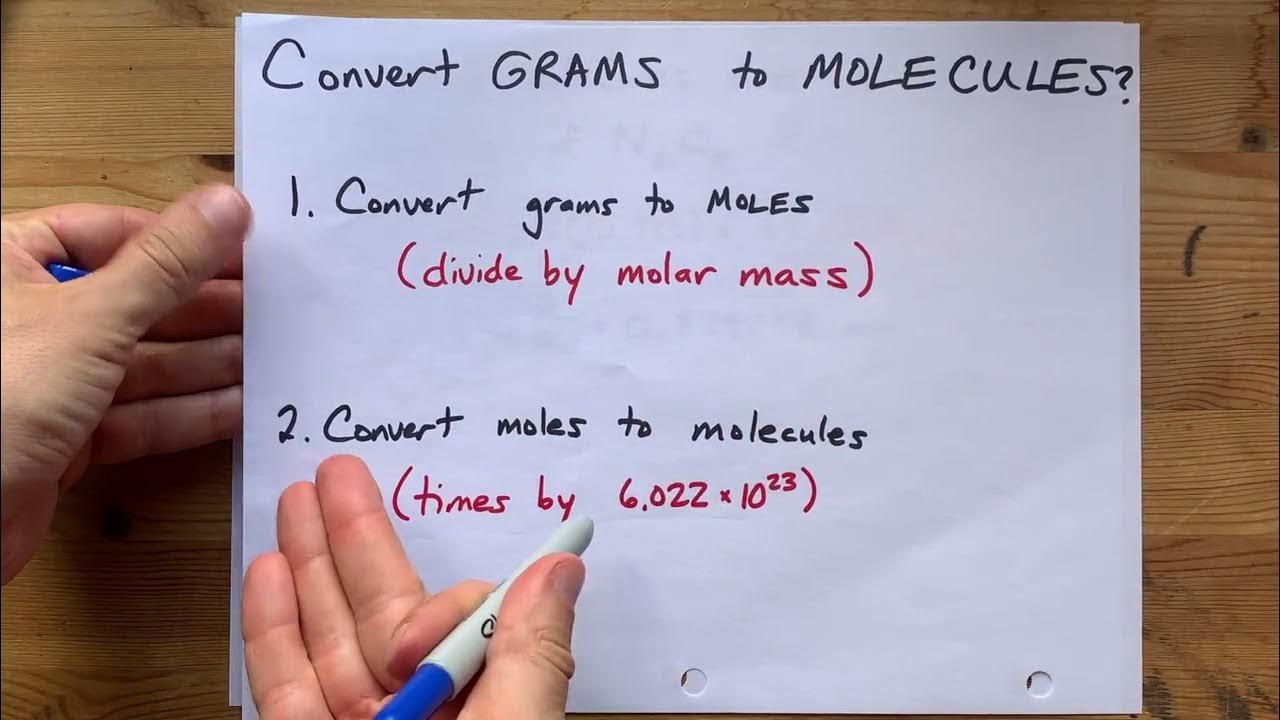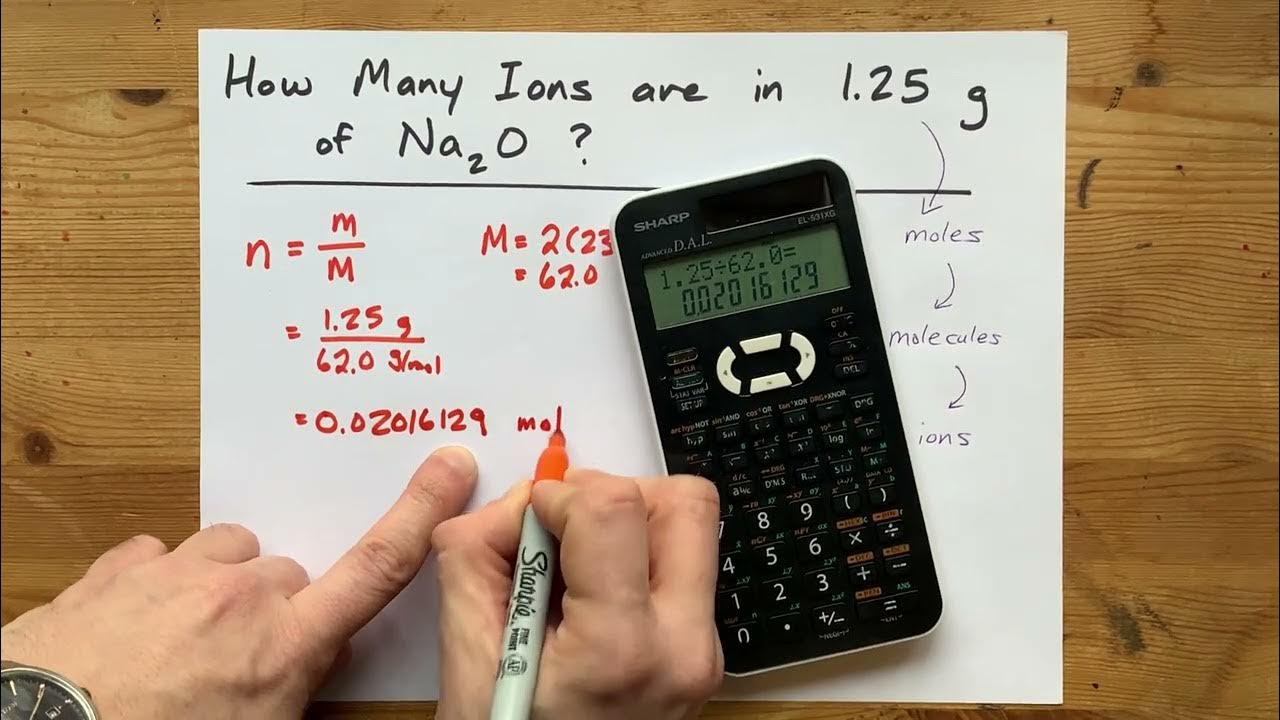How many atoms of Aluminum are in 0.250 grams of aluminum?
TLDRThis script demonstrates the process of calculating the number of aluminum atoms in 0.25 grams of the element. It involves converting grams to moles using the atomic mass of aluminum (27.0 g/mol), and then multiplying the resulting moles by Avogadro's number (6.022 x 10^23) to find the atom count. The video emphasizes the importance of significant figures, rounding the final result to 5.58 x 10^21 atoms, aligning with the precision of the given atomic mass.
Takeaways
- 🔍 To determine the number of atoms in a given mass of aluminum, you must first convert grams to moles using the atomic mass of aluminum.
- ⚖️ The molar mass of aluminum is approximately 27.0 grams per mole, which is used to divide the mass of aluminum to find moles.
- 📐 The conversion from grams to moles is represented by the formula n = mass / molar mass.
- 📉 The initial mass of aluminum provided in the script is 0.250 grams.
- 🔢 After dividing 0.250 grams by the molar mass of aluminum, the result is approximately 0.00925926 moles.
- 🌌 To find the number of atoms, multiply the number of moles by Avogadro's number, which is 6.022 × 10^23 atoms per mole.
- 🔄 The script demonstrates the use of a calculator to perform the necessary scientific calculations, including exponentiation.
- 📲 The script mentions the use of a calculator's 'exp' or 'e' button to input exponential notation for large numbers.
- 📝 The final result of the calculation is approximately 5.5759 × 10^21 atoms of aluminum.
- 📈 The importance of significant figures is emphasized, with the final answer rounded to three significant figures, resulting in 5.58 × 10^21 atoms.
- 📚 The script suggests that the periodic table used may have inaccuracies, as it only provides three significant figures for the atomic mass of aluminum.
Q & A
What is the first step to determine the number of atoms in a given mass of aluminum?
-The first step is to convert grams into moles by dividing the mass by the atomic mass of aluminum.
What is the atomic mass of aluminum used in the script?
-The atomic mass of aluminum used in the script is 27.0 grams per mole.
How many moles of aluminum are in 0.25 grams according to the script?
-There are approximately 0.00925926 moles of aluminum in 0.25 grams.
What is Avogadro's number and how is it used in this context?
-Avogadro's number is 6.022 x 10^23, and it is used to convert moles of a substance into the number of individual atoms or molecules.
How does one convert moles of aluminum to atoms?
-To convert moles to atoms, multiply the number of moles by Avogadro's number.
What is the significance of scientific notation in the calculation presented in the script?
-Scientific notation is used to express very large numbers, such as the number of atoms, in a more manageable form.
What is the final number of aluminum atoms calculated in the script?
-The final number of aluminum atoms calculated is 5.5759 x 10^21.
Why is it important to consider significant figures in scientific calculations?
-Significant figures are important to ensure the precision of the result is consistent with the precision of the measurements and calculations involved.
How many significant figures are in the original number given in the script?
-The original number given in the script has three significant figures.
What is the final answer rounded to in terms of significant figures?
-The final answer is rounded to three significant figures, which is 5.58 x 10^21 atoms.
Why does the script mention that leading zeros do not count in significant figures?
-Leading zeros are not counted in significant figures because they do not contribute to the precision of the number; only the non-zero digits and the first zero after a decimal point are considered significant.
Outlines
🔍 Calculating Aluminum Atoms from Grams
This paragraph explains the process of determining the number of aluminum atoms in a given mass. It starts by emphasizing the need to convert grams to moles using the atomic mass of aluminum, which is approximately 27.0 grams per mole. The molar mass is then used to find the number of moles in 0.25 grams of aluminum, resulting in approximately 0.009259 moles. The next step involves multiplying this number of moles by Avogadro's number (6.022 x 10^23) to convert moles to the number of atoms. The calculation yields approximately 5.5759 x 10^21 atoms. The paragraph concludes by discussing the importance of significant figures, rounding the final answer to three significant figures, which is 5.58 x 10^21 atoms.
Mindmap
Keywords
💡Aluminum
💡Atoms
💡Grams
💡Moles
💡Molar Mass
💡Avogadro's Number
💡Significant Figures
💡Scientific Notation
💡Calculator
💡Exponent
💡Conversion
Highlights
The process of counting atoms in a given mass of aluminum involves converting grams to moles and then moles to atoms.
Conversion from grams to moles is achieved by dividing the mass by the atomic mass of aluminum.
Aluminum's molar mass is approximately 27.0 grams per mole.
Moles are then converted to atoms by multiplying by Avogadro's number.
Avogadro's number is used because aluminum is composed of atoms, not molecules.
The formula for calculating the number of particles is the number of moles times Avogadro's number.
Avogadro's number is approximately 6.022 x 10^23.
The calculation of moles of aluminum results in approximately 0.00926 moles.
Multiplying the moles of aluminum by Avogadro's number gives the number of atoms.
The result of the calculation is approximately 5.5759 x 10^21 atoms of aluminum.
Significant figures in the original number and the periodic table guide the final answer's precision.
The final answer should have three significant figures, rounded appropriately.
Leading zeros are not counted when determining significant figures, but trailing zeros after a decimal are counted.
The importance of using scientific notation for large numbers in calculations is emphasized.
The transcript provides a step-by-step guide on how to perform the calculations.
The transcript explains the use of the 'exp' button on calculators for scientific notation.
The transcript encourages asking questions for further clarification.
The transcript concludes with a summary of the process and an invitation for further engagement.
Transcripts
5.0 / 5 (0 votes)
Thanks for rating:





